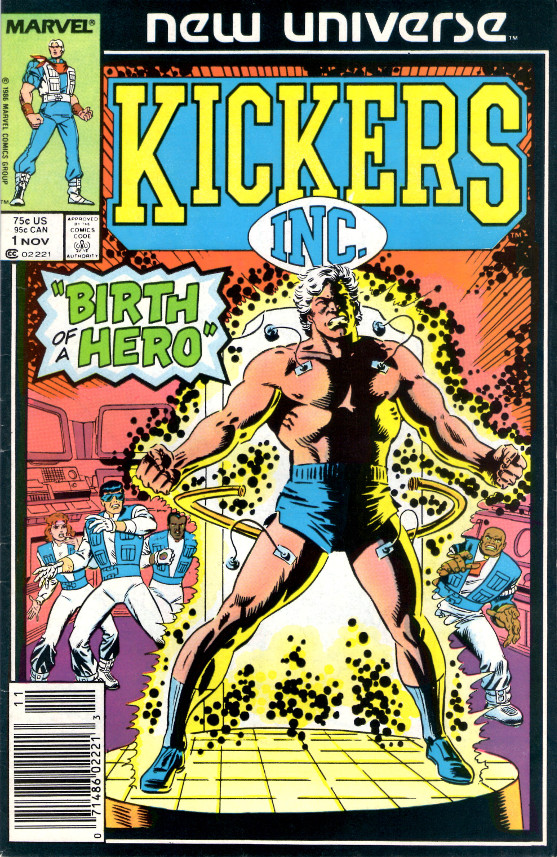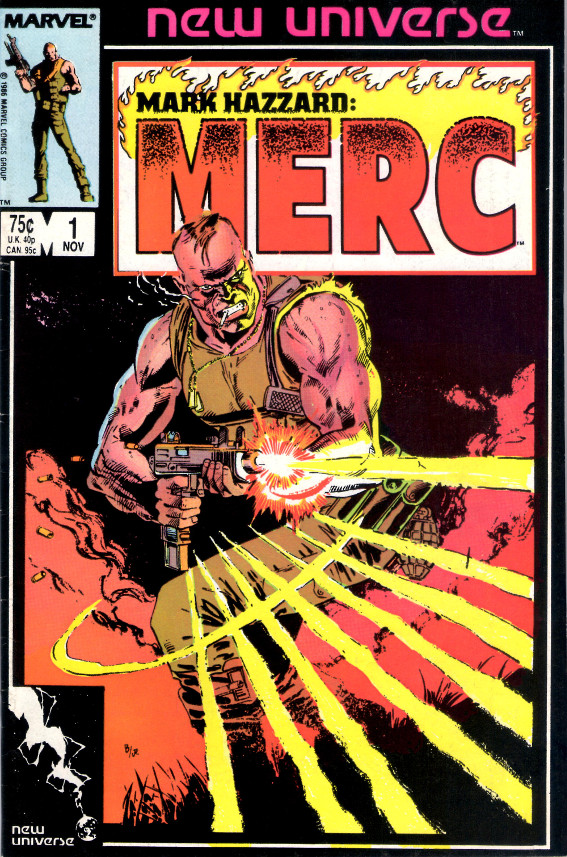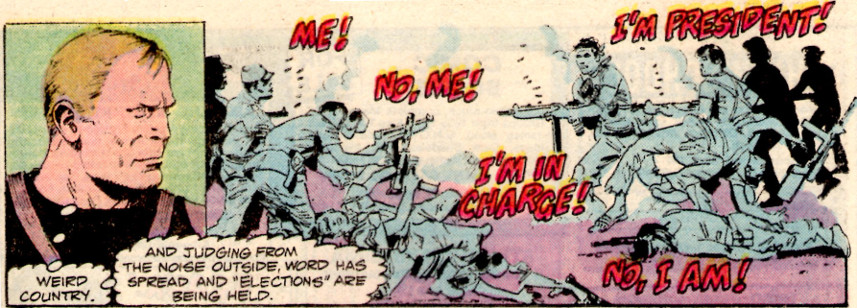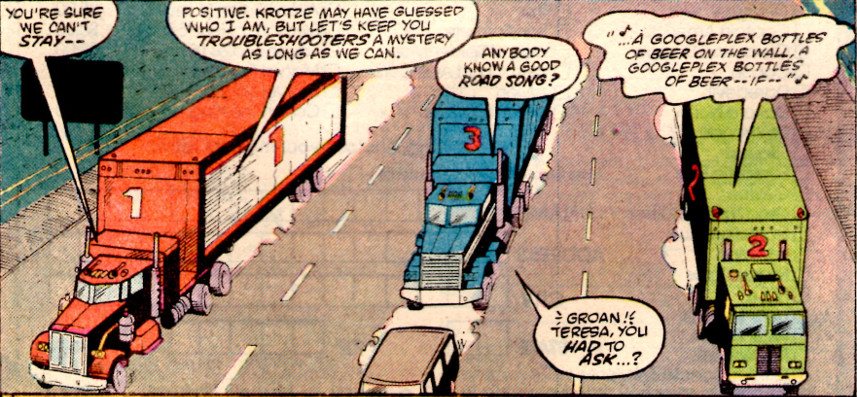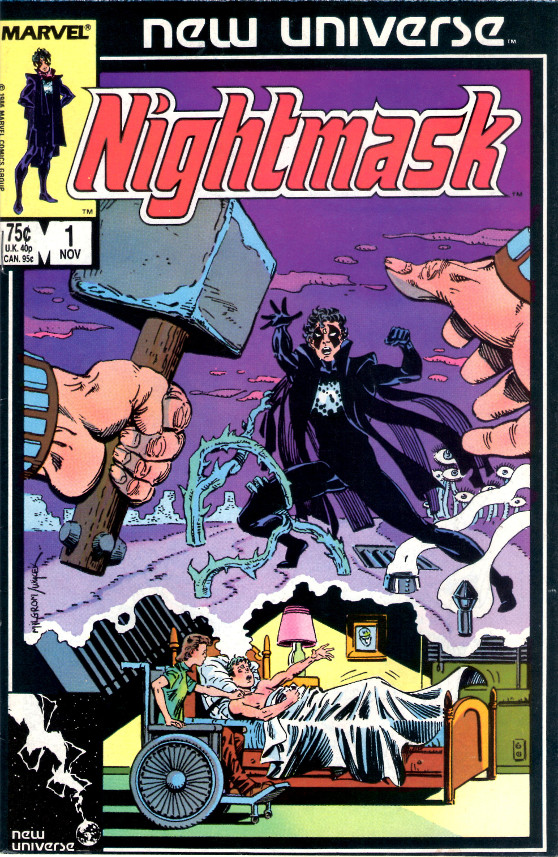New Universe – Part 2: The Supporting Books
This month’s column covers the smaller-run books in the New Universe. Originally conceived with the hope that each would become a regular, ongoing, and essential independent title, these series underwent a marked change in tone and direction about 3/4 of the way through their first year. At this turning point, it seems clear that the Marvel editorial staff had decided to pivot the entire New Universe line to a more integrated set of books that would serve as an extended, interlocking set of graphic novels more than anything else.
The specific series that made it only to their first anniversary were Kickers Inc., Mark Hazzard: Merc, Spitfire and the Troublemakers, and Nightmask. As will be discussed in detail below, each of these series was mostly independent and oblivious of the rest of the NU when it was launched. At the turning point, all four became grimmer and three of them (all but Nightmask) became supporting vignettes for escalating tensions between the United States and Russia. In addition, the lead characters would be spun off into the larger The Pitt and The War storylines that would come later.
Kickers Inc. (12 issues)
The first of the short-lived books and definitely the weakest in terms of premise and overall storyline was Kickers Inc., which sported 8 different writers over its 12-issue run.
Created by Tom DeFalco and Ron Frenze, the plot line followed the star quarterback of the New York Smashers, Jack Magniconti, who acquires super-human speed, endurance, and strength. The original explanation offered, at least to the characters within the framework, is that Jack’s brother has exposed the star athlete to a state-of-the-art performance enhancing substance, although later Jack’s power is attributed to the White Event.
The series never got its legs underneath it and the reader was left wondering what there was to care about and how it had anything to do with the world outside his window. After his metamorphosis, Magniconti founds a non-profit aid group comprised of himself, his wife, and three of his teammates. Their aim was to help people who had nowhere else to turn. This idea never panned out and the trajectory of the story ping-ponged between the group, Jack’s guilt over having an unfair advantage on the gridiron, and a ludicrous situation where the owner of the team, a vindictive harpy, plays Jack in a tennis match to decide the fate of the team. Not to mention the ludicrous notion that a set of professional athletes would have the time and skill to run around the world confronting bad guys risking their football careers.
Kickers Inc. finally settled in on a much grimmer plot where the footballers are played by the CIA into doing their dirty work.
These events later set the stage for Captain Magniconti being at the forefront of the paranormal soldiers who were drafted to fight in the World War III events that unfold at the end of the NU line.
Mark Hazzard: Merc (12 issues & 1 annual)
Initially conceived and written by Peter David, Mark Hazzard: Merc was the odd-man out of all of the NU books. There was no tie-in with the White Event, and the initial stories, while interesting at times, offered nothing in terms of the science fiction theme that Shooter claimed he wanted as central to the NU.
Instead, David’s plots focused on the attempts to balance work and home life of the titular character.
This approach was certainly consistent with the ‘world outside your window’ tagline but not with anything else NU had to offer. David left after only writing four issues and was subsequently replaced by Doug Murray, who stayed at the helm for the remainder. At times, his depiction of armed conflict was downright silly,
but eventually the series started to deal honestly with the costs of war. The art was far more of an issue and, by my count, there were 11 different illustrators used in 13 different tales.
The book also features one of the most unusual moves ever published – the death of the main character before the end of the series. In the annual published between issues 11 and 12, a mortally wounded Mark Hazzard is taken off life support and allowed to die peacefully in his sleep
The final issue, entitled Merc, followed the secondary characters and their adventures in the Middle East and Near East Asia that had appeared in the latter half of the series. The only lasting feature of the book was the introduction of the Afghan conflict as a central plot point that would be knitted into the World War III scenario.
Spitfire and the Troublemakers (13 issues)
Elliot R. Brown and Jack Morelli conceived of this series but, oddly enough, contributed only to the first issue; a sign of the chaos that swirled around the launch of the NU.
According to the Wikipedia entry, Brown is on record as saying:
about the original concept for the series. Unfortunately, Gerry Conway, who wrote the first 6 issues, must not have gotten the memo as his plots really couldn’t have been more farcical.
As mentioned in the last post, Conway’s stories covered the adventures of the far too brilliant female MIT professor by the name of Jenny Swensen (nicknamed Spitfire by her father) and her four favorite students who were already accomplished engineers and scientists and mechanics and truck drivers and so on (sure, every college student at MIT has a commercial driver’s license and knows how to handle a big rig – it’s a requirement in the application).
This series also had no direct tie-in with the White Event, and its initial place in the NU was unclear. The basic premise was that Swensen’s father had invented an exoskeleton (called M.A.X.) while in the employ of an evil business man. This crooked captain of industry, Fritz Kroetze by name, subsequently killed Papa Swensen in order to lay claim to armor that he paid for in the first place. Has nobody heard of contract law? Also, why are all technological geniuses such poor judges of character?
Jenny, judging herself morally entitled to her father’s work rather than the man who bore the development cost, steals the armor and off she goes. It is true that she struggles with the ethics of this choice and she gets tossed in jail for some of her actions in the suit, but that is the extent of the ‘world outside your window’ motif. Mostly, this phase of the book could be best thought of in terms of the kind of super-science found in Spy Kids (without as much humor and charm).
Neither Swensen nor her cadre of young groupies ever seemed bound by the constraints normal people suffer. They never seemed to be stumped for ideas, or to need sleep, or make mistakes. With that much drive and know-how, they could have started their own tech-giant and simply bought out the ‘bad guy’ rather than resorting to theft. Alternatively, they could have even invented a better suit and had a real mechanical donnybrook with the original. Not that this latter scenario would have been realistic but at least it would have been consistent and entertaining.
Thankfully, when Conway’s run ended, Cary Bates took the book in a whole different direction. Along the way Jenny and her gang had crossed paths with a terrorist who they defeated and humiliated. He returns with a vengeance and kills off most of the Troublemakers, showing that knowledge and cunning are two different things.
With her reputation in tatters and her band of merry kids dead or discouraged, Swensen is easily pressed into CIA service and is given a better M.A.X. armor (see, I knew that someone other than her father could do it). Her subsequent adventures overlap with the Afghanistan conflict, further advancing the imminent World War III scenario. In the final stage of her development, NU editors decide that Swensen is more interesting when she is made of metal rather than being inside of a metal suit. Exposure to the bizarre substances from The Pitt slowly transform her into a female analog of the X-Men character Colossus and she becomes the reoccurring character Chrome in the last third of the D.P. 7 series.
Nightmask (12 issues)
The final entry in the short-and-not-sweet group of NU publications is Nightmask. Created by Archie Goodwin, the premise revolves around a young man named Keith Remsen who has acquired the ability to enter other people’s dreams.
In the first issue, Keith is thrown into a coma as a result of an explosion designed to kill his parents and which, incidentally, turned his sister into a paraplegic. Though not clearly tied to the White Event, Keith awakens from his coma after its occurrence with the ability to project his consciousness into the mind of a dreamer.
The idea of dream walking had been around for a long time but mostly in the realm of movies (e.g. Dreamscape). One notable comics exception is the first Doctor Strange story ever written in which the Master of the Mystic Arts journeys into the dreams of a haunted sleeper only to encounter Nightmare. However, all these stories seemed a bit hollow as they seemed to lack real-world consequences. It would take another 3 decades or so until the movie Inception would go on to show us just how compelling the whole idea could be.
Unfortunately, like the other dream-based tales of its time, Nightmask also failed to capture the cool aspect of shared visions. Instead, many of the earlier stories centered on Remsen getting some kind of revenge on his parent’s assassin (interestingly, the final revenge story had to wait 20 years for publication in the Untold Tales of the New Universe). Eventually, Goodwin would drop away from the stories and Roy Thomas ended up writing the series until its cancellation. These later stories were no more interesting and the publication run closed on a voodoo storyline that was boring at best. In addition to the lackluster plots, the graphics left much to be desired. Although there is a clear homage to the Ditko style used on Doctor Strange
the art on most of the books seemed rushed – a problem that plagued the entire NU line.
The Nightmask character outlived his book and became a pivotal figure in the World War III scenario, with Keith Remsen working as an Army officer whose prime responsibility is to judge the fitness for service of other paranormals who have been drafted. His one wrong call on an unbalanced recruit haunts him as the man ends up becoming a serial killer who literally assassinates his victims by blowing up them and himself. Keith finally feels that the only way to set things right is to kill the assassin; an action that drives him mad with guilt.
Next month, I’ll close out this look at the New Universe by delving into the longer running titles that provided the richer storylines.

